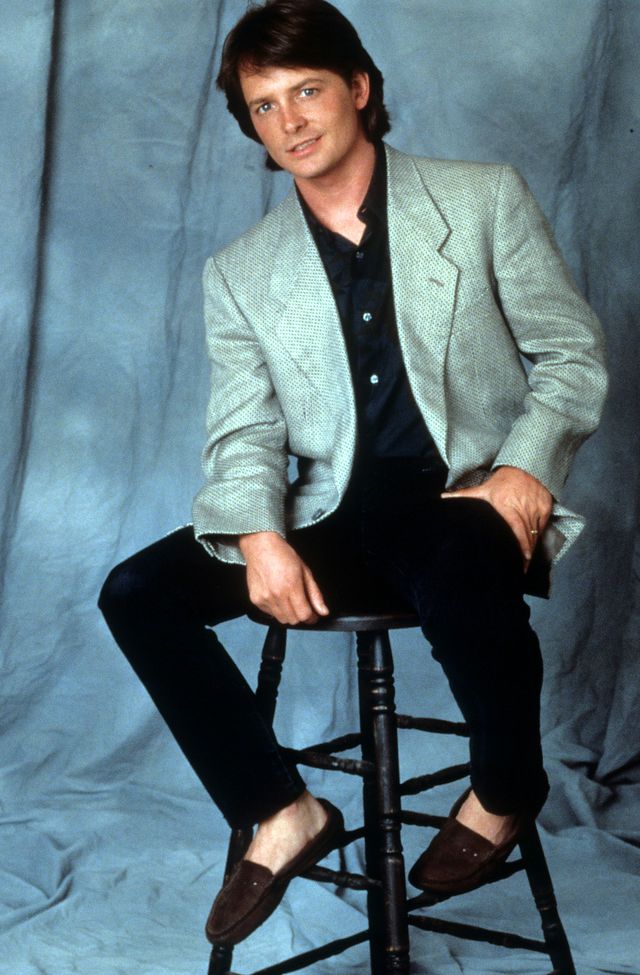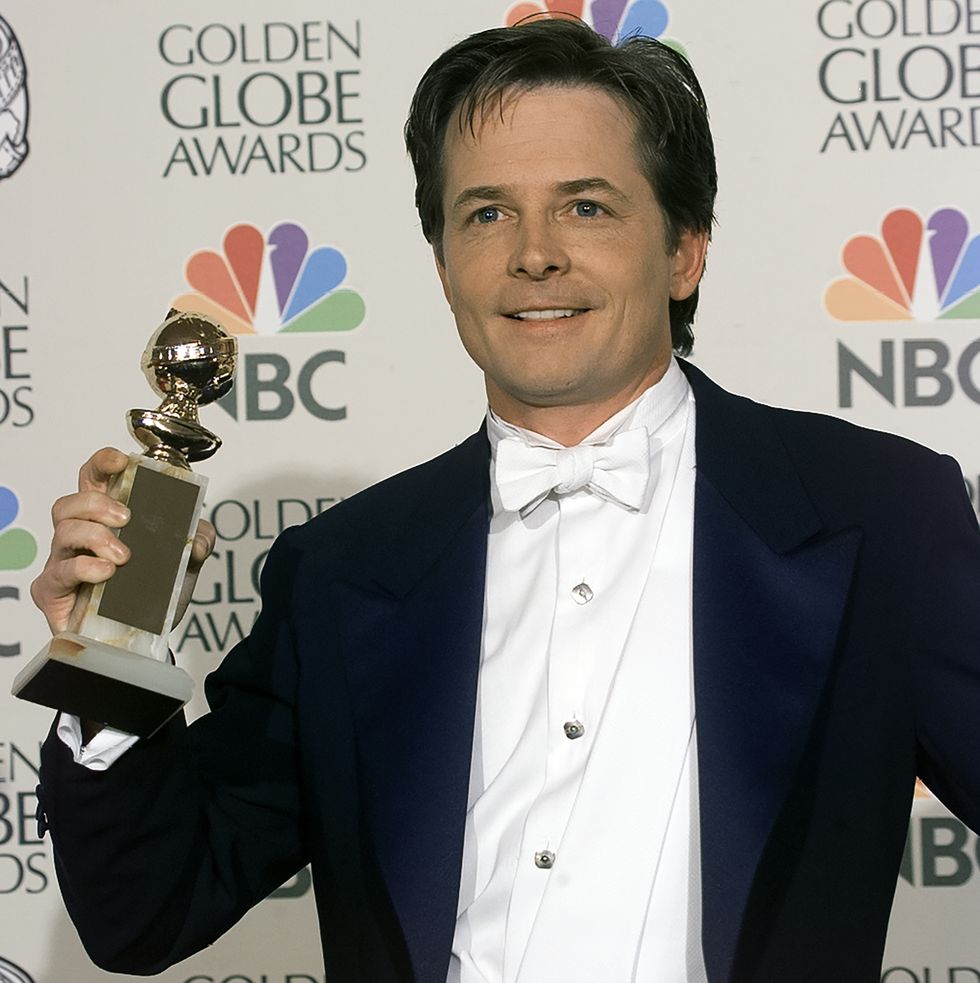Like many kids, Michael J. Fox had his eyes on a career as a rock star. “I grew up admiring rockstars like Jimi Hendrix and Jimmy Page,” he told The New York Times Magazine. “That’s what I thought being famous was. But I wasn’t a rock star.”
Many might argue that the Canadian actor is a rock star in a different way. His Michael J. Fox Foundation has raised more than $1 billion to fund research to find a cure for Parkinson’s, a degenerative disease that has affected Muhammad Ali, Neil Diamond, Jesse Jackson, Ozzy Osbourne, Linda Ronstadt, and Fox himself, who was diagnosed in 1991.
Since going public with his diagnosis in 1998, the Back to the Future and Family Ties star hasn’t shied away from speaking out about the disease’s impact on his life and championing the search for a cure.
“I refer to Parkinson’s and the effect it’s had on my life as a gift—and people are completely dubious of that and kind of wonder how I could say that,” he told CNN in 2010. “I... qualify it by saying it’s a gift that keeps on taking, but it is a gift, because it’s really opened me up to more kind of compassionate, curious, risk-taking person.”
Now, the 61-year-old is opening up more than ever in Still: A Michael J. Fox Movie. The documentary, directed by Davis Guggenheim and releasing on Apple TV+ on Friday, offers an intimate retrospective of how one of the biggest stars of the ’80s has handled a life-changing disease. In Still, Fox talks about his life and his health, and the physical toll the disease has already taken on him is apparent from the trailer.
This April, Fox revealed to CBS News he had a benign tumor removed from his spine that has impacted his ability to walk. He has also broken several bones after falling. “I’m not going to be 80,” he said in the interview.
Fox wasn’t always this frank about his Parkinson’s. Back in the ’90s, he spent seven years suffering from and learning about the disease while keeping his condition out of the spotlight—until he finally felt ready to share.
Fox’s career was thriving when he first noticed twitching in his hand
For seven seasons from 1982 to 1989, Fox played Alex P. Keaton on the hit sitcom Family Ties, winning three Emmys for portraying a Republican with liberal parents who were former hippies. In the midst of his television success, he also found silver screen fame in the Back to the Future trilogy as Marty McFly from 1985 to 1990. Off-screen, he married Family Ties costar Tracy Pollan in 1988, and they had their first of four children in 1989.
Life was looking good, as he kept landing starring movie roles, one after the other. But while he was on the Gainesville, Florida, set of Doc Hollywood in 1991, something felt off. He noticed a twitch in his left pinkie finger. A neurologist assured him that he had probably somehow injured his funny bone, as he explained to People.
But six months later, things were worse. His entire left hand was trembling, and his shoulder was stiff and achy. He consulted another doctor and was told he had Parkinson’s disease, which typically affects patients over the age of 60. He was just 29 years old. “It was incomprehensible,” he told People. “The doctor said I would be able to function for years and years. But even talking in those terms was strange.”
He got four doctors’ opinions before accepting his fate
When he shared the news with Pollan, she cried out of fear. “Neither of us quite understood. We hugged each other and assured ourselves that we’d be able to deal with it,” Pollan told People.
It just didn’t seem right. Fox was young and in good shape, and doctors agreed that he must have been misdiagnosed. But after four doctors had the same initial reaction followed by the same eventual diagnosis, there was no escaping. He searched for an explanation. What mistake did he make in his life that caused this?
After ruling out everything from childhood hockey accidents to film stunts, he realized the truth. “There’s just that thing—fate,” he explained to People. “You’re the guy it touches.”
Fox says he was “so scared” during the early years
Accepting his newfound reality, Fox tried to move forward with his life. He leaned too heavily on drinking, before eventually course-correcting and giving up alcohol altogether. At home, his young son Sam dubbed his left hand “the shaky hand” and made a game of it, but at work, it was getting harder to hide. As photographers and reporters anxiously awaited his arrival at the Golden Globes in January 1998, he stalled in the limo as his left arm and leg shook uncontrollably. He asked the driver to take another spin around the block. Three spins later, his medication kicked into effect, and he was able to proceed without anyone aware of his secret. He even snagged the Best Actor trophy that night.
It wasn’t that he was ashamed of it. It was just that he had to learn how to deal with it on his own. So Fox continued working, telling whoever needed to know, but mostly keeping it to a tight group.
Those seven years saw a period where he focused on comedies that floundered at the box office: Life with Mikey (1993), For Love or Money (1993) and Greedy (1994). “My decision-making was ridiculous,” he said of the time, in a New York Times Magazine article from 2019. “It wasn’t based on truth.”
Looking back on that period now, he’s able to admit his vulnerability. “I was so scared,” Fox explained to New York Times Magazine. “I was so unfamiliar with Parkinson’s. Someone is saying your life is going to be completely changed. Yeah? When?” He admits he took on projects because of “time restrictions” and “financial pressures” because they were “inflated in my head,” so he chose as many “quick successful movies” as he could.
Eventually, he came to terms with choosing his projects more strategically: “It should’ve been to do as many good ones as I could. To do one good one. To find something that meant something to me. And it wasn’t until 1994 that I started getting it. That’s when I started to accept the disease—and acceptance doesn’t mean resignation. It means understanding and dealing straightforwardly.”
He told TV execs about his Parkinson’s before Spin City
After the successful 1995 film The American President, he decided it was time to step away from films and stay in one place with a TV show. And that’s when the ABC sitcom Spin City about the New York City mayor’s office came along.
Before stepping into the lead role as Mike Flaherty, he revealed his diagnosis to the network’s then-president Robert Iger and the production company DreamWorks’ head Jeffrey Katzenberg. “I said it could get very bad or not get bad. They said, ‘Let’s go!’” Fox recalled to People. The show ran for six seasons, from 1996 to 2002.
By the end of the second season, he knew it was time to openly talk about what he had privately been dealing with for so long. He revealed his diagnosis to his castmates and then headed to Massachusetts for a risky four-hour brain procedure.
The surgery helped. He returned to the show that fall, but by the end of 1998, he was ready to speak even more publicly and revealed his diagnosis on the cover of the December 7, 1998 issue of People.
Fox remains optimistic that there will be a cure
From the start, his attitude about his diagnosis was clear and became his trademark: optimism mixed with reality.
After four seasons on Spin City, Fox decided to step away. “One of the reasons I left Spin City was that I felt my face hardening,” he told The New York Times Magazine. “My movements were constricted. If you watch episodes from the last couple of seasons, you’ll see I would anchor myself against a desk or the wall. Eventually, it was too burdensome.”
Knowing his limits—and knowing where to channel his energy—became his priority. In 2000, he launched the Michael J. Fox Foundation for Parkinson’s Research and has poured most of his efforts into its work ever since. Fox has been known to pick up a guitar at his foundation’s annual benefit and reprise the iconic Back to the Future “Johnny B. Goode” scene, with Coldplay’s Chris Martin even joining him in 2013. After all, Fox is a true rock star.
The nonprofit has funded numerous clinical trials and other research in the name of ending the disease. “I still believe in a cure,” he told The New York Times Magazine in 2019.
This April, a study that relied, in part, on Fox Foundation data found a biomarker associated with Parkinson’s that could pave the way for the first lab test able to confirm a diagnosis. It might also predict who is likely to develop the disease. “This is, this changes everything,” Fox told CBS News. “I know with where we are right now, in five years, we’ll be able to tell if they have it, be able to tell if they ever get it, we’ll know how to treat it.”
Watch Still: A Michael J. Fox Movie on Apple TV+
Still, a documentary about and featuring Michael J. Fox, begins streaming on Apple TV+ on May 12.
Adrienne directs the daily news operation and content production for Biography.com. She joined the staff in October 2022 and most recently worked as an editor for Popular Mechanics, Runner’s World, and Bicycling. Adrienne has served as editor-in-chief of two regional print magazines, and her work has won several awards, including the Best Explanatory Journalism award from the Alliance of Area Business Publishers. Her current working theory is that people are the point of life, and she’s fascinated by everyone who (and every system that) creates our societal norms. When she’s not behind the news desk, find her hiking, working on her latest cocktail project, or eating mint chocolate chip ice cream.
















